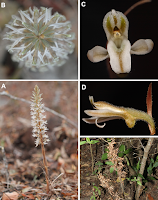[Most Recent Entries] [Calendar View]
Sunday, May 29th, 2022
| Time | Event | ||||
| 3:24p | [Botany • 2022] Pachygenium laurense (Orchidaceae: Spiranthinae) • A New Orchid Species from Argentina—Morphological Evidence and Phylogenetic Reconstruction
Abstract Background: Pachygenium embraces a group of terrestrial species formerly placed in Pelexia sensu lato. The genus currently comprises some 60 species, most of which are known from the southern parts of Brazil and Paraguay, with few species distributed in the Andean countries—only four species have been recorded from Argentina so far. In Jujuy Province, Argentina a new species of Pachygenium was found during our fieldwork. The aim of this article was to provide morphological and molecular evidence for its membership in this genus. Methods: Materials from specimens were collected in the field and examined by classical taxonomic and molecular biological techniques, e.g., PCR and sequencing DNA. Phylogenetic reconstruction was performed by maximum-likelihood and Bayesian inference. Results: Pachygenium laurense from Argentina is described and illustrated based on morphological evidence and its taxonomic position was confirmed by phylogenetic analyses. A new combination for Pachygenium gutturosa is also proposed. A key for identification is provided for the Pachygenium species occurring in Argentina. Conclusion: Pachygenium laurense is the fifth species of the genus recorded from Argentina.
Pachygenium laurense C.M. Martín & Szlach. sp. nov. Diagnosis: Species leafless at anthesis, with very characteristic arrangements of the flowers in inflorescence, ecallose, undivided lip, and narrow, slender gynostemium. Etymology: The name of the species refers to the place where it was collected for the first time (Estancia Las Lauras).  Pachygenium gutturosa (Rchb.f.) Szlach., Dudek & C.M. Martín, comb. nov. Claudia M. Martin, Adriana Marisel Morales, Magdalena Dudek and Dariusz L. Szlachetko. 2022. Pachygenium laurense (Orchidaceae, Spiranthinae), A New Orchid Species from Argentina—Morphological Evidence and Phylogenetic Reconstruction. PeerJ. 10:e13433 . DOI: 10.7717/peerj.13433 | ||||
| 4:00p | [Ichthyology • 2022] Evolutionary Relationships of Anglerfishes (Lophiiformes) reconstructed using Ultraconserved Elements
Highlights • The evolutionary history of anglerfishes is unclear. • We constructed molecular phylogenies of Lophiiformes using UCE loci. • We recovered novel topologies for the Ceratioidei deep-sea anglerfishes. • Three new frogfish families were proposed and Antennariidae was re-evaluated. • We resolved relationships among frogfishes but deep-sea anglers remain uncertain. Abstract The macroevolutionary consequences of evolving in the deep-sea remain poorly understood and are compounded by the fact that convergent adaptations for living in this environment makes elucidating phylogenetic relationships difficult. Lophiiform anglerfishes exhibit extreme habitat and predatory specializations, including the use of a fin-spine system as a luring device and unique reproductive strategies where parasitic males attach and fuse to females. Despite their notoriety for these odd characteristics, evolutionary relationships among these fishes remain unclear. We sought to clarify the evolutionary history of Lophiiformes using data from 1000 ultraconserved elements and phylogenomic inference methods with particular interest paid to the Ceratioidei (deep-sea anglerfishes) and Antennarioidei (frogfishes and handfishes). At the suborder level, we recovered similar topologies in separate phylogenomic analyses: The Lophioidei (monkfishes) are the sister group to the rest of the Lophiiformes, Ogcocephaloidei (batfishes) and Antennarioidei (frogfishes) form a sister group, and Chaunacioidei (coffinfishes) and Ceratioidei (deep-sea anglerfishes) form a clade. The relationships we recover within the ceratioids disagree with most previous phylogenetic investigations, which used legacy phylogenetic markers or morphology. We recovered non-monophyletic relationships in the Antennarioidei and proposed three new families based on molecular and morphological evidence: Histiophrynidae, Rhycheridae, and Tathicarpidae. Antennariidae was re-evaluated to include what was known as Antennariinae, but not Histiophryninae. Non-bifurcating signal in splits network analysis indicated reticulations among and within suborders, supporting the complicated history of the Lophiiformes previously found with morphological data. Although we resolve relationships within Antennarioidei, Ceratioidei relationships remain somewhat unclear without better taxonomic sampling. Keywords: Phylogenomics, UCEs, Target capture, Next-generation sequencing, Deep sea Pamela B. Hart, Rachel J. Arnold, Fernando Alda, Christopher P. Kenaley, Theodore W. Pietsch, Destinee Hutchinson and Prosanta Chakrabarty. 2022. Evolutionary Relationships of Anglerfishes (Lophiiformes) reconstructed using Ultraconserved Elements. Molecular Phylogenetics and Evolution. 171; 107459. DOI: 10.1016/j.ympev.2022.107459 |
| << Previous Day |
2022/05/29 [Calendar] |
Next Day >> |









